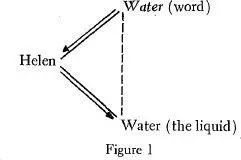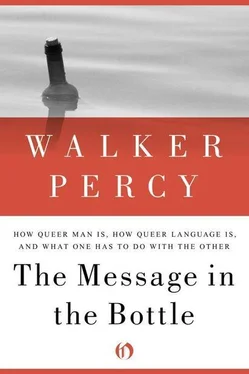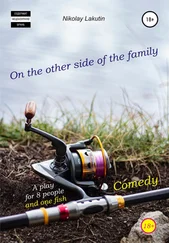American behaviorists kept solid hold on the world of things and creatures, yet couldn’t fit the symbol into it.
German idealists kept the word as internal form, logos, and let the world get away. From Kant to Cassirer, man became ever more securely locked up inside his own head. Even outside happenings seemed to be ordered by the interior forms of the mind. All questions could be given inside answers — except the kind of awkward questions children ask: Yes, but how does it happen that you can talk and I can understand you? Or, how does it happen that you can write a book and I can read it? Or, if the world is really unknowable, why do scientists act as if there were something out there to be known and as if they could even get at the truth of the way things are?
Accordingly, I was sitting at my desk in Louisiana on a summer day in the 1950’s wondering whether this split in human knowing was not in the very nature of things and whether, also, that peculiar and most human of all phenomenon, language, did not fall between the two, and was not somehow unapproachable from either, a forbidden island, a terra incognita.
My instincts, I confess, were on the side of the scientists in general and in particular on the side of the hardheaded empiricism of American behavioral scientists. The entire spectacular history of modern science seemed to bear out their unspoken assumption that there was indeed something to be known out there and it was worth the effort to try to find out what it was.
Yet the natural scientists, with all their understanding of interactions, energy exchanges, stimuli, and responses, could not seem to utter a single word about what men did and what they themselves were doing: observing and recording, telling and listening, uttering sentences and hearing sentences, writing papers and reading papers, delivering lectures, listening to the six o’clock news, writing a letter to one’s daughter in college.
Was it possible, I wondered, to preserve the objective stance of the psychologist, which always seemed so right and valuable to me, which assumes there are real things and events happening, and to make some sense out of what happens when people talk and other people listen and understand or misunderstand? Maybe it wasn’t possible, to judge from the spectacular default of the behaviorists when confronted by language as behavior. Not since Noam Chomsky wrote his famous review of Skinner’s Verbal Behavior has it been possible to take seriously the application to language of the old stimulus-response theory, however refined and modified it might be.
Sitting there in Louisiana, I was thinking about these things. Then I began thinking about what happened between Helen Keller and Miss Sullivan in Tuscumbia, Alabama, on another summer morning in 1887. You recall the story. The heart of it is in three short paragraphs. Earlier, Helen had learned to respond like any other good animal: When she wanted a piece of cake, she spelled the word in Miss Sullivan’s hand and Miss Sullivan fetched her the cake (like the chimp Washoe, who gives hand signals: tickle, banana, etc.). Then Miss Sullivan took her for a walk.
We walked down the path to the well-house, attracted by the fragrance of the honeysuckle with which it was covered. Someone was drawing water and my teacher placed my hand under the spout. As the cool stream gushed over one hand, she spelled into the other the word water, first slowly then rapidly. I stood still, my whole attention fixed upon the motion of her fingers. Suddenly I felt a misty consciousness as of something forgotten — a thrill of returning thought; and somehow the mystery of language was revealed to me. I knew then that “w-a-t-e-r” meant the wonderful cool something that was flowing over my hand. That living word awakened my soul, gave it light, hope, joy, set it free! There were barriers still, it is true, but barriers that could in time be swept away.
I left the well-house eager to learn. Everything had a name, and each name gave birth to a new thought. As we returned to the house every object which I touched seemed to quiver with life. That was because I saw everything with the strange, new sight that had come to me. On entering the door I remembered the doll I had broken. [She had earlier destroyed the doll in a fit of temper.] I felt my way to the hearth and picked up the pieces. I tried vainly to put them together. Then my eyes filled with tears; for I realized what I had done, and for the first time I felt repentance and sorrow.
I learned a great many new words that day. I do not remember what they all were; but I do know that mother, father, sister, teacher were among them — words that were to make the world blossom for me, “like Aaron’s rod with flowers.” It would have been difficult to find a happier child than I was as I lay in my crib at the close of that eventful day and lived over the joys it had brought me, and for the first time longed for a new day to come.
If there was a bifurcation in our knowledge of ourselves and our peculiar and most characteristically human activity, with a terra incognita in between concealing the mystery, surely I was straddling it and looking straight down at it. Here in the well-house in Tusumbia in a small space and a short time, something extremely important and mysterious had happened. Eight-year-old Helen made her breakthrough from the good responding animal which behavorists study so successfully to the strange name-giving and sentence-uttering creature who begins by naming shoes and ships and sealing wax, and later tells jokes, curses, reads the paper, writes La sua volontade e nostra pace, or becomes a Hegel and composes an entire system of philosophy.
For a long time I had believed and I still believe that if one had an inkling of what happened in the well-house in Alabama in the space of a few minutes, one would know more about the phenomenon of language and about man himself than is contained in all the works of behaviorists, linguists, and German philosophers.
What did happen?
Once again, as I had done many times before and as my hardheaded professor had taught me, I began drawing diagrams, behaviorist models, showing the usual arrows. After all the arrows were there: Miss Sullivan traced certain sensory patterns in Helen’s hand, which were then coded by the touch receptors in the skin and transmitted by afferent nerves to the sensory cortex, the gray matter of the brain. And, at least in the incident with the cake, once Helen received a “word” which she had learned to associate with a certain pleasant consequence, other arrows could be drawn showing that Helen’s attention and behavior were directed to the fetching and eating of the cake. Then did something of the sort happen in the well-house? Begin then with this diagram:

Now I had something very close to Ogden and Richards’s triangle. The arrows showed “real causal” relations between the word water spelled in Helen’s hand and Helen’s brain, and between the brain event which issues in Helen’s attention being directed toward the “referent,” the water flowing over her other hand.
What about the relation between the word water and the water itself? There is no “real causal” relation but only the relation of naming which Miss Sullivan teaches Helen to “impute” between the two. So, if we want to follow Ogden and Richards, we can draw a dotted line between the word water and the water and call it an “unreal imputed relation.”
But wait. Something was very wrong. For one thing, I felt like handing a piece of chalk to Professors Ogden and Richards, inviting them to the blackboard, and making a polite request: Would you mind drawing me a picture of an “unreal imputed relation”? What does the dotted line mean?
Читать дальше













